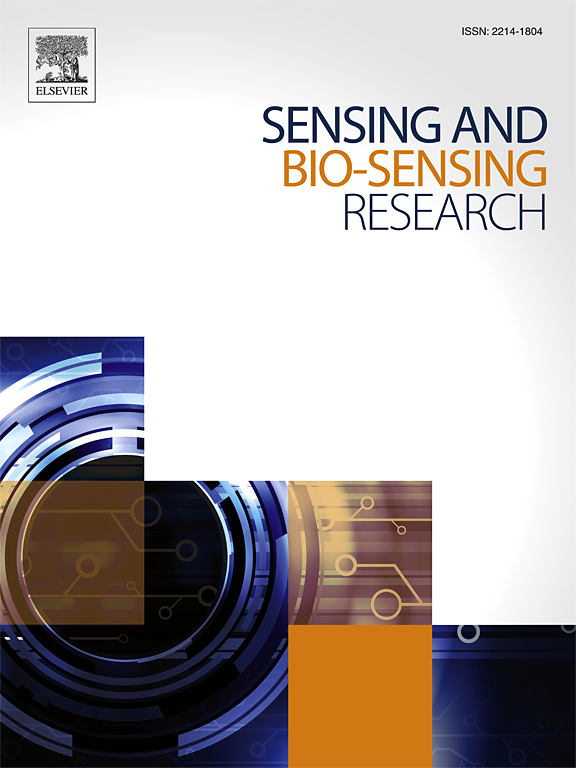无标记金纳米颗粒功能化肽树状聚合物生物传感器用于新冠肺炎疫苗患者突破性感染的视觉检测
IF 5.4
Q1 CHEMISTRY, ANALYTICAL
引用次数: 0
摘要
鉴于全球正在实施有效的COVID-19疫苗,但这些疫苗不能提供完全免疫,因此监测突破性感染的发生至关重要,特别是针对新出现的严重急性呼吸综合征冠状病毒2 (SARS-CoV-2)变体。因此,我们开发了一种无标记比色测定方法,使用具有高活性核衣壳(N)蛋白表位的肽树状大分子功能化的金纳米颗粒(GNPs)。该检测依赖于在缺乏抗sars - cov - 2n抗体的情况下,由肽树突包裹的GNPs聚集引起的吐温-20诱导的比色变化,反之亦然。透射电子显微镜、动态光散射和圆二色光谱分析都表明,在GNPs上形成了均匀且高度稳定的肽树状大分子涂层。表面等离子体共振实验表明,该蛋白与树突状肽和抗SARS-CoV-2 N抗体具有较强的结合亲和力,KD值为525 nM。为了验证概念验证,我们在70份人血清样本上测试了该方法,受试者工作特征曲线分析显示出较高的诊断灵敏度(88.89%)和特异性(100%)。这种方法为开发简单快速的诊断分析方法开辟了新的途径,用于识别针对病毒感染和其他病原体的抗体。本文章由计算机程序翻译,如有差异,请以英文原文为准。

A label-free gold nanoparticles functionalized peptide dendrimer biosensor for visual detection of breakthrough infections in COVID-19 vaccinated patients
Given the global implementation of effective COVID-19 vaccines, which do not confer complete immunity, it is crucial to monitor the occurrence of breakthrough infections, particularly against newly emerging severe acute respiratory syndrome coronavirus 2 (SARS-CoV-2) variants. Hence, we developed a label-free colorimetric assay using gold nanoparticles (GNPs) functionalized with a peptide dendrimer incorporating highly reactive epitopes of the nucleocapsid (N) protein. This assay relies on the tween-20 induced colorimetric changes caused by the aggregation of peptide dendrimer-coated GNPs in the absence of anti- SARS-CoV-2 N antibodies, and vice versa. Transmission electron microscopy, dynamic light scattering, and circular dichroism spectroscopy analyses all showed the formation of a uniform and highly stable coating of the peptide dendrimer over GNPs. Surface plasmon resonance experiments have demonstrated a strong binding affinity for the peptide dendrimer and anti- SARS-CoV-2 N antibodies, with a KD value of 525 nM. To validate the proof-of-concept, we have tested this assay on seventy human serum samples, and receiver operating characteristic curve analysis demonstrated high diagnostic sensitivity (88.89 %) and specificity (100 %). This approach opens up new avenues for the development of simple and rapid diagnostic assays for identifying antibodies against viral infections and other pathogens.
求助全文
通过发布文献求助,成功后即可免费获取论文全文。
去求助
来源期刊

Sensing and Bio-Sensing Research
Engineering-Electrical and Electronic Engineering
CiteScore
10.70
自引率
3.80%
发文量
68
审稿时长
87 days
期刊介绍:
Sensing and Bio-Sensing Research is an open access journal dedicated to the research, design, development, and application of bio-sensing and sensing technologies. The editors will accept research papers, reviews, field trials, and validation studies that are of significant relevance. These submissions should describe new concepts, enhance understanding of the field, or offer insights into the practical application, manufacturing, and commercialization of bio-sensing and sensing technologies.
The journal covers a wide range of topics, including sensing principles and mechanisms, new materials development for transducers and recognition components, fabrication technology, and various types of sensors such as optical, electrochemical, mass-sensitive, gas, biosensors, and more. It also includes environmental, process control, and biomedical applications, signal processing, chemometrics, optoelectronic, mechanical, thermal, and magnetic sensors, as well as interface electronics. Additionally, it covers sensor systems and applications, µTAS (Micro Total Analysis Systems), development of solid-state devices for transducing physical signals, and analytical devices incorporating biological materials.
 求助内容:
求助内容: 应助结果提醒方式:
应助结果提醒方式:


